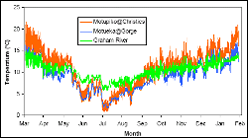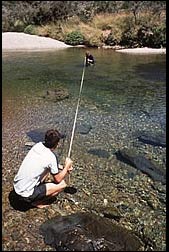River monitoring
Research Status: Ongoing |
Water temperature at three sites in the catchment |
Introduction
A catchment-wide monitoring network is important in any catchment study. It is necessary to know the current status of water quality and river health and to use these results as baselines against which future interventions or changes can be measured.
One of the issues that is being addressed as part of the Motueka ICM project is how water quality varies across the catchment. The main questions involved with this work are:
- How does water quality differ among streams running through different land use types?
- How does water quality change along the length of the Motueka River?
- How much nitrogen and phosphorus and how many harmful bacteria are being washed down the Motueka River and out into Tasman Bay?
Research Approach
Initially, routine monitoring was carried out monthly, but later, due to the cost, the frequency was extended out to 3-monthly and only at stable flows (not after any significant rain). In the field, a range of parameters are measured including: DO (mg/L), DO (% Saturation), Temp, Water Clarity, Conductivity, pH, flow at ungauged sites. Other parameters for which Samples collected for subsequent laboratory analysis include: E.coli, faecal coliforms, and nutrients (DRP, TP, NO3-N, TN; at a few sites only). In the past many samples were taken for Suspended Solids (Total, fixed and volatile) and Campylobacter.
There are 16 monitoring sites covering a range of stream sizes, geologies and vegetation covers.
Research Results
A technical report has also been prepared (Tasman District Council Ref: R05007 and Cawthron Report No. 933 , June 2005)(see Publications 2004-2005") by Roger Young (Cawthron Institute), Trevor James (TDC) and Joe Hay (Cawthron Institute) presenting results of the Tasman District Council’s “State of the Environment Surface Water Quality Monitoring Programme from 1999 to April 2004.
This report incorporates monitoring data collected by National Water Quality Network (NIWA) from 1989 to 2003 and other data including data collected as part of the ICM Motueka programme.
 |
 |
Measuring black disc water clarity at Cobb River |
Invertebrate sampling |
Recent Publications
Recent Presentations
| Year | Title | File Size |
| 2006 | Nutrient discharge from the Motueka catchment into Tasman Bay, 2005. |
|
BMPs, BEPs and Guidelines
| Title | Description |
| Stormwater – swales | Swales are vegetated areas used in place of curbs or paved gutters to transport stormwater runoff. T...More » |
| ANZECC Water Quality Guidelines |
from MfE web site. The Australian and New Zealand Environment and Conservation Council (ANZEC...More » |
| Microbiological Water Quality Guidelines for Marine and Freshwater Recreational Areas |
From guide: The Microbiological Water Quality Guidelines for Marine and Freshwater Recreationa...More » |
| Using the Cultural Health Index: How to assess the health of streams and waterways |
Edited from website: This guide explains how to iwi can apply the Cultural Health Index (cultu...More » |
| A National Protocol for State of the Environment Groundwater Sampling in New Zealand |
From website: This document provides a step–by–step protocol for the collection of...More » |
| A User Guide for the Macroinvertebrate Community Index |
From website: This guide provides an expert view on best–practice use of the Macroinvert...More » |
| Check, Dlean, Dry: Didymo Factsheet for Whitebaiters |
From website: Whitebaiters need to clean nets and other gear betweeen waterways to help slow t...More » |
| New Zealand Periphyton Guideline: Detecting, Monitoring and Managing Enrichment of Streams |
From MfE website. A background review of the structure and value of periphyton communities in ...More » |
| Stream Periphyton Monitoring Manual |
From guide: Describes a standard set of methods to enable Regional Councils, consultants and r...More » |
| New Zealand Stream Health Monitoring and Assessment Kit | This kit enables non–scientists to collect consistent, scientifically valid information from s...More » |
| Regional Guidelines for Ecological Assessments of Freshwater Environments : Macroinvertebrate sampling in wadeable streams | This guideline covers macroinvertebrate sampling of perennial wadeable streams. In addition to guid...More » |
Primary Contacts:

|
Trevor James
Email |
Institute Tasman District Council |
Expertise Water Quality and Aquatic Ecology |

|
Rob Merrilees
Email |
Institute NIWA |
Expertise Environmental monitoring |

|
Roger Young
Email Phone: (03) 548 2319 Fax: (03) 546 9464 |
Institute Cawthron Institute |
Expertise Land/water interactions, water quality, fisheries, river health |